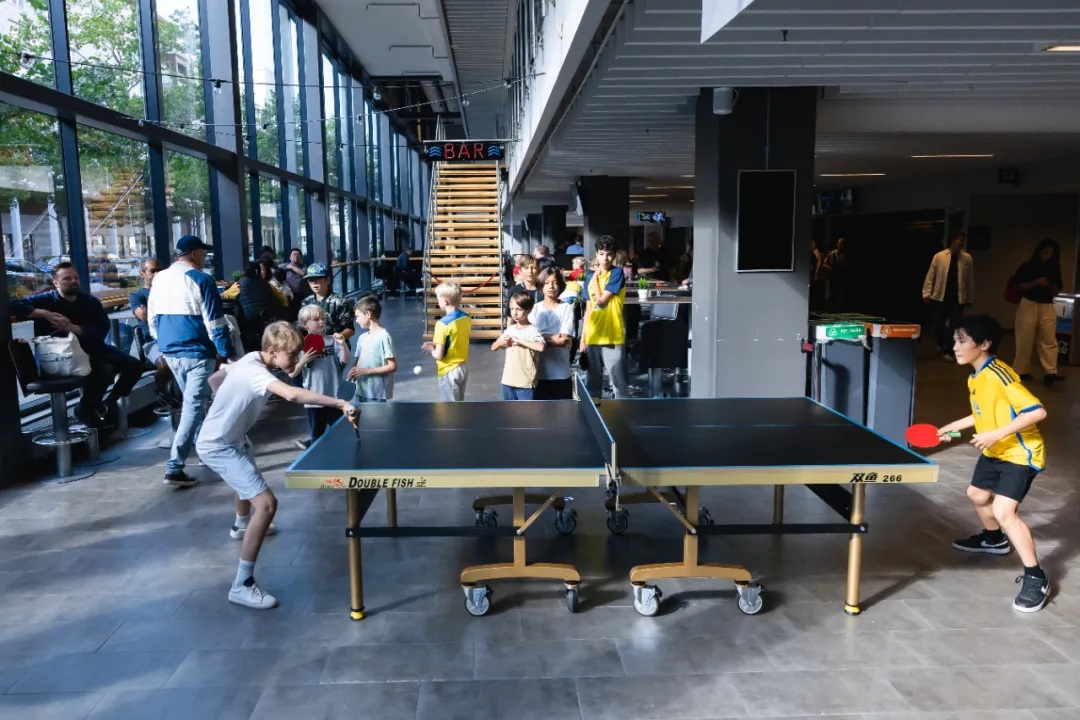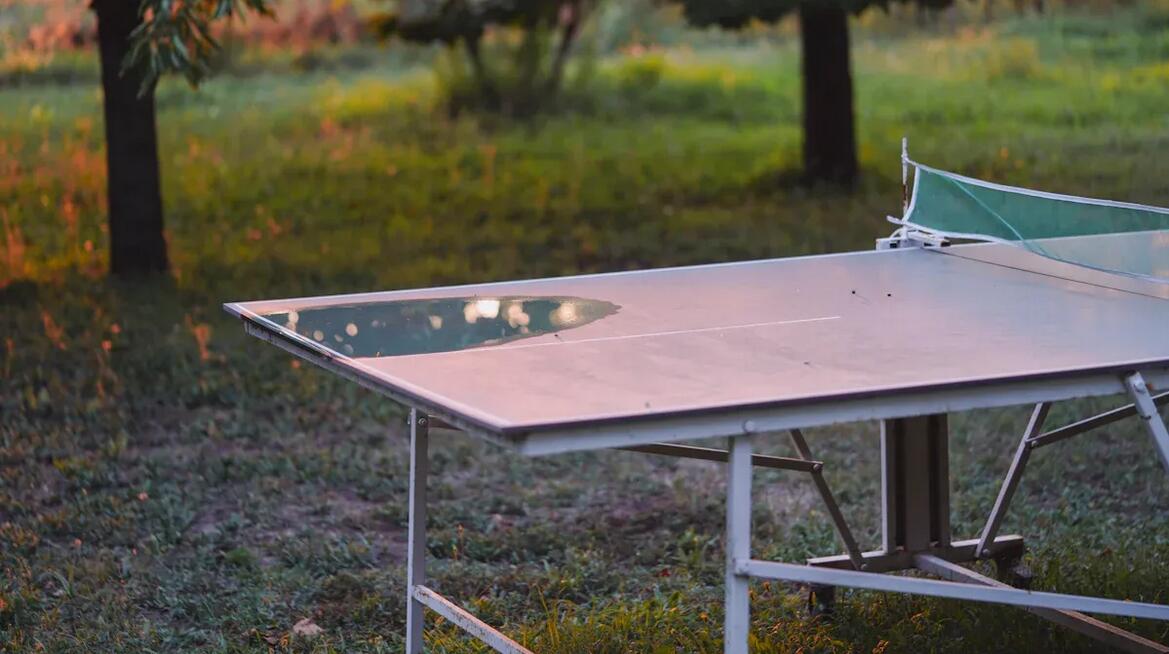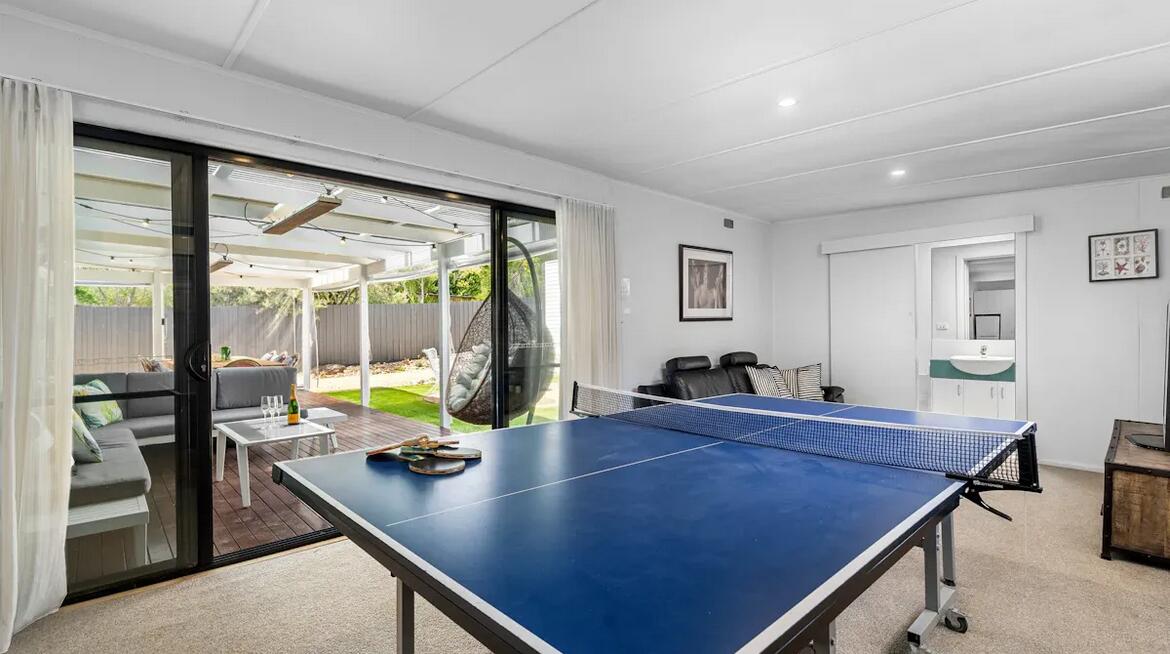В чем разница между столами для настольного тенниса в помещении и на открытом воздухе?

Сравнение столов для настольного тенниса в помещении и на открытом воздухе
Изучите основные различия между столами для настольного тенниса в помещении и на открытом воздухе.
| Функции | Столы для настольного тенниса в помещении | Столы для настольного тенниса на открытом воздухе |
|---|---|---|
| Состав материала | Изготовлено из дерева или МДФ. | Изготовлены из алюминия или обработанной древесины. |
| Качество отказов | Обеспечивает стабильный и высокий отскок. | Отскок ниже и менее предсказуем. |
| Устойчивость к погодным условиям | Не устойчив к влаге и солнцу. | Спроектирован так, чтобы выдерживать дождь и ультрафиолетовые лучи. |
| Долговечность | Прочный, но может деформироваться под воздействием влажности. | Высокая устойчивость к суровым погодным условиям. |
| Расходы | В целом менее затратно. | Обычно стоит дороже из-за материалов. |
| Требования к хранению | Нуждается в сухих, стабильных условиях. | Можно хранить на открытом воздухе под защитой. |
| Сетевая система | Съемные сетки для легкой регулировки. | Стационарные сетки, предназначенные для использования на открытом воздухе. |
| Транспортабельность | Тяжелее, менее портативен. | Часто оснащается колесиками для удобства перемещения. |
Теннисные столы для игры в помещении и на улице — это разные вещи. Теннисные столы для игры в помещении сделаны из дерева, что обеспечивает мячу стабильный отскок. В отличие от... уличный стол для настольного тенниса изготовлен из металла или других прочных материалов, что позволяет ему выдерживать суровые погодные условия. водонепроницаемый стол для настольного тенниса обеспечивает защиту от дождя, что делает его идеальным для использования на открытом воздухе. Двойная рыба , уважаемый производитель оборудования для настольного тенниса , производит оба типа столов, чтобы удовлетворить потребности разных игроков.
Ключевые выводы
- Столы для игры в помещении изготавливаются из дерева. Они обеспечивают устойчивый отскок, что хорошо для серьёзных игр. Более толстые поверхности позволяют играть лучше.
- Уличные столы изготовлены из прочных материалов, таких как алюминий и обработанная древесина. Такие столы дольше служат под дождём и солнцем. Они отлично подходят для парков и открытых площадок.
- Прежде чем выбрать стол, подумайте, где вы будете играть. Столы для помещений лучше всего подходят для сухих и ровных мест. Столы для улицы выдерживают любую погоду.
Материалы

Материалы для столов в помещении
Столы для настольного тенниса в помещении созданы для комфортной игры и хорошего отскока мяча. Большинство столов для настольного тенниса имеют столешницу из массива дерева, ДСП или фанеры. Толщина столешницы обычно составляет от 19 до 25 мм. Более толстые столешницы обеспечивают лучший и более резкий отскок. Столы для соревнований часто имеют столешницу толщиной 25 мм. Это оптимальный вариант для крупных турниров. Профессиональные столы Butterfly имеют деревянную столешницу толщиной 2,5 см (1 дюйм). Благодаря этому мяч всегда отскакивает одинаково.
Совет: толстые поверхности предотвращают деформацию и обеспечивают стабильный отскок. Это важно для игроков, стремящихся к совершенствованию.
Doublefish — надёжный бренд инвентаря для настольного тенниса. Они используют прочную древесину и современные методы сборки столов для настольного тенниса. Их столы служат долго и надёжно. Многие игроки выбирают их именно по этим причинам.
| Тип материала | Влияние на качество отскока | Примечания |
|---|---|---|
| 12 мм/15 мм/18 мм/25 мм | Отскок изменяется в зависимости от толщины | Выбирайте на основе своего уровня мастерства |
| 30 мм (конкурсного класса) | Лучший отскок для серьезной игры | Подходит для продвинутых игроков. |
| Стальная рама | Делает стол устойчивым | Прочный и служит долго |
| Деревянная ходовая часть | Укрепляет стол | Дает прочную основу |
Столы для помещений не выдерживают воздействия погодных условий. Влага может привести к разбуханию древесины или её растрескиванию. Храните такие столы в сухом месте.
Материалы для уличных столов
Уличные теннисные столы должны выдерживать любые погодные условия. Производители используют для их изготовления металл, бетон и обработанную древесину. Алюминиевые столешницы прочны и не ржавеют. Оцинкованные детали делают стол прочным и защищают его от воды. Специальные покрытия защищают стол от солнца и выцветания. Обработанные поверхности не пропускают воду и не деформируются.
Уличные столы Doublefish прочные и имеют покрытие, устойчивое к погодным условиям. Это обеспечивает их безопасность и позволяет эффективно использовать их на улице.
| Материал | Вклад в устойчивость к погодным условиям |
|---|---|
| Алюминиевые столешницы | Прочный, не ржавеет и не подвержен коррозии |
| Оцинкованная фурнитура | Прочный, не пропускает влагу |
| Покрытие для наружных работ | Блокирует солнце, предотвращает выцветание |
| Обработанная поверхность | Удерживает воду, предотвращает деформацию |
| Прочная конструкция | Устойчив к ветру |
| Гладкие поверхности | Легко чистить, меньше пыли |
Столы для настольного тенниса на открытом воздухе изготовлены из водонепроницаемых материалов. Это позволяет теннисному столу выдерживать дождь, солнце и ветер. Толщина и материалы могут быть разными. Главная цель — обеспечить устойчивость стола и защитить его от непогоды.
Примечание: Уличные столы стоят дороже, чем столы для помещений. Это связано с использованием прочных материалов и специальных покрытий.
Подпрыгивать
Отскок стола в помещении
Столы для настольного тенниса в помещении обеспечивают стабильный отскок. Толстая деревянная поверхность обеспечивает мячу быстрый и ровный отскок. Игроки предпочитают столы для настольного тенниса для тренировок и матчей. Отскок остается одинаковым по всей поверхности стола. Толщина и качество древесины имеют большое значение. На большинстве крупных турниров используются столы со столешницей толщиной 25 мм. Такая толщина обеспечивает наилучший отскок для быстрой игры.
Стабильный отскок помогает игрокам совершенствоваться и хорошо прицеливаться.
Ниже представлена таблица, показывающая, как эксперты оценивают качество отказов:
| Тип таблицы | Описание качества отказов |
|---|---|
| Столы для помещений | Более толстые поверхности и прочные материалы улучшают отскок. |
| Уличные столы | Металлические или деревянные столешницы замедляют отскок. |
Уличный стол для прыжков
Уличные столы используют металл или обработанную древесину. Эти поверхности поглощают больше энергии. Мяч отскакивает ниже и медленнее. Погода может изменить траекторию мяча. Ветер может толкать мяч, затрудняя прогнозирование ударов. Жара и влажный воздух влияют на поведение мяча и ощущения игроков. Солнечный свет или тени могут мешать игрокам и затруднять прицеливание.
| Фактор | Описание |
|---|---|
| Воздушный поток и ветер | Даже небольшой ветерок может сдвинуть мяч и затруднить удары. |
| Температура и влажность | Они влияют на отскок мяча и то, как долго игроки могут сосредоточиться. В очень жаркую или холодную погоду сложно играть хорошо. |
| Условия освещения | Яркий свет или тени могут беспокоить игроков и затруднять обзор, поэтому прицеливаться и реагировать становится сложнее. |
| Шум и отвлекающие факторы | Громкие звуки или движение могут отвлечь игрока в важные моменты. |
Игрокам, которым нужен стабильный отскок, стоит выбирать столы для помещений. Уличные столы хороши для увлекательной игры и выдерживают погодные условия, но отскок у них не такой хороший, как у столов для помещений.
Долговечность
Долговечность теннисного стола
Прочность — важный фактор при выборе теннисного стола. Столы для настольного тенниса в помещении изготавливаются из толстой древесины или прочной ДВП. Это делает стол прочным и устойчивым. Более толстые столы служат дольше и обеспечивают более плавный отскок. Многие столы для настольного тенниса имеют стальную раму. Рама делает стол прочнее и обеспечивает устойчивость во время игры.
Уличные столы подвергаются большей нагрузке от погодных условий и эксплуатации. Они изготовлены из алюминия, обработанной древесины, стекловолокна или смолы. Эти материалы не ломаются и не гнутся. Стекловолокно и смола очень прочные. Они не трескаются и не деформируются даже при ежедневной игре. Каркасы уличных столов толще и изготовлены из металла, который не ржавеет. Это обеспечивает устойчивость стола даже при сильном ветре.
- Уличные столы служат дольше благодаря материалам, устойчивым к погодным условиям.
- Толстые столы лучше отскакивают и остаются прочными в течение многих лет.
- Прочные рамы предотвращают тряску стола.
- Покрытия из стекловолокна и смолы хорошо подходят для мест с большой проходимостью на открытом воздухе.
Doublefish производит столы для использования в помещении и на улице с прочными каркасами и качественной поверхностью. Их столы отлично подходят для использования в школах, клубах и парках.
Устойчивость к погодным условиям
Уличные столы отличаются тем, что они устойчивы к погодным условиям. Для них используются специальные покрытия и материалы, защищающие от дождя, солнца и ветра. Качественные чехлы из полиэстера защищают стол от воды, плесени и солнечных лучей. Чехлы оснащены пряжками и завязками для фиксации. Ручки позволяют снять чехол, когда вы хотите поиграть. Светлые чехлы отражают солнечный свет и обеспечивают лучшую защиту.
| Особенность | Описание |
|---|---|
| Материал | Хороший полиэстер не пропускает воду, плесень и солнечные лучи. |
| Эффективность | Дешевые чехлы могут не обеспечить надлежащей защиты стола. |
| Функции | Чехлы оснащены пряжками, завязками и ручками для удобства использования. |
| Цвет | Светлые цвета лучше защищают от солнца, чем темные. |
Уличные столы должны быть полностью защищены от непогоды, если они находятся на улице круглый год. Внутренние столы можно оставлять на улице на короткое время, но им необходима защита от солнца и влажного воздуха. Самый простой способ защитить стол от дождя и грязи — использовать чехол.
Совет: Всегда накрывайте стол, когда не играете. Это продлит срок его службы и сохранит поверхность гладкой.
Уличные столы Doublefish обладают защитой от непогоды. Благодаря этому они остаются прочными даже после многих сезонов на открытом воздухе.
Столы стоят дороже, потому что должны выдерживать дождь, солнце и ветер. Покупателям следует учитывать, как часто они будут пользоваться столом и где будут его хранить.
Хранение и транспортировка

Хранение столов в помещении
Теннисные столы для настольного тенниса в помещении требуют бережного хранения. Влажность может стать причиной проблем с ними. Намокнув, древесина может погнуться или изменить форму. Это происходит во влажных помещениях, таких как гаражи или подвалы. Деформация может повредить поверхность и края. Это снижает удовольствие от игры. Многие игроки используют чехлы для защиты столов. Чехлы защищают столы от пыли и влаги.
Совет: размещайте столы в сухих помещениях. Поддерживайте постоянную температуру. Используйте чехол, чтобы защитить стол от воздействия влаги.
Некоторые распространенные проблемы, возникающие при хранении столов в помещении:
- Влажность может привести к деформации стола.
- Изменение температуры может повредить стол.
- На поверхности может скапливаться пыль.
У столов Doublefish для помещений прочные каркасы и гладкие столешницы. Однако их необходимо беречь от влаги. Правильное хранение продлит срок службы стола и обеспечит его хорошую упругость.
Хранение на открытом воздухе
Уличные теннисные столы легко хранить и перемещать. Производители добавляют функции, облегчающие их перемещение и хранение. Такие столы отлично подходят для парков и общественных мест. Многие уличные столы складываются для экономии места. У них есть колёса, чтобы их можно было катить.
| Особенность | Описание |
|---|---|
| Компактная складная конструкция | Компактно складывается для экономии места |
| Центральные колеса | Колеса облегчают перемещение стола. |
| Система блокировки | Замки обеспечивают безопасность стола при хранении. |
| Складные ножки | Ножки складываются для удобства хранения |
| Быстрая сборка | Большинство столов поставляются практически готовыми к использованию. |
| Вездеходные ролики | Большие колеса катятся по неровной земле |
| Прочная конструкция | Толстые ножки и регулировочные винты обеспечивают устойчивость стола. |
Уличные столы Doublefish отличаются продуманной конструкцией и прочными деталями. Эти столы отлично подходят для парков, школ и детских садов. Их легко перемещать и хранить в труднодоступных местах. Благодаря своей конструкции стол остаётся в безопасности и готов к игре даже при частом перемещении.
Сеть и аксессуары
Чистые разницы
Сетки для настольного тенниса различаются для столов для игры в помещении и на улице. Для столов для игры в помещении сетки снимаются. Вы можете выбрать сетки с зажимами или сетки с клипсами. Сетки с зажимами позволяют регулировать высоту и натяжение. Сетки с клипсами быстро устанавливаются и снимаются. Эти сетки легко менять или чинить. Для столов для игры в настольный теннис на улице используются сетки, которые не снимаются. Производители крепят их к столу или стойке. Это означает, что столы для игры на улице всегда готовы к игре. Стационарные сетки сложно заменить из-за особенностей их конструкции.
| Тип сети | Описание |
|---|---|
| Нестандартные фиксированные сети | Прикрепляется к столу, легко использовать, трудно менять |
| Сетки-зажимы | Вы можете настроить и удалить их. |
| Сетки-клипсы | Быстро устанавливается, легко снимается |
Уличные сетки должны выдерживать дождь, солнце и ветер. Материалы, из которых они изготовлены, предотвращают ржавчину и выцветание. Внутренние сетки не имеют такой защиты. Они не подходят для использования на улице.
Совет: если вы предпочитаете легкий уход, выбирайте сетки, которые можно снимать для столов в помещении.
Совместимость аксессуаров
Для столов, предназначенных для использования в помещении, и для уличных столов используются разные аксессуары. Для столов, предназначенных для использования в помещении, используются обычные сетки и комплектующие. В магазинах продаётся множество сеток, стоек и зажимов для них. Для уличных столов требуются прочные, устойчивые к погодным условиям аксессуары. Их комплектующие часто изготавливаются индивидуально для каждого стола. Это затрудняет поиск новых деталей.
| Особенность | Столы для помещений | Уличные столы |
|---|---|---|
| Сетевая система | Сетки легко снимаются | Сетки остаются на месте, их трудно поменять |
| Материал | Не создан для плохой погоды | Сделано для использования на открытом воздухе |
| Запасные части | Легко найти в магазинах | Часто особенный для каждого стола |
Doublefish продаёт столы с соответствующими аксессуарами для обоих типов. Для столов Doublefish для помещений используются обычные сетки и комплектующие. Уличные столы оснащены прочными сетками и фурнитурой для использования на улице. Перед покупкой всегда проверяйте, подходят ли аксессуары к вашему столу, особенно для уличных столов.
Пригодность
Внутренняя среда
Теннисные столы для помещений лучше всего подходят для использования в закрытых помещениях. В этих помещениях не должно быть сыро или слишком солнечно. Влажный воздух может привести к трещинам на столе. Столы для настольного тенниса могут погнуться под воздействием солнца. Столы для помещений не выдерживают непогоду. Не ставьте их рядом с окнами или влажными местами. В школах, клубах и дома эти столы используются для тренировок и игр. Столы для помещений обеспечивают стабильный отскок и плавную игру. Это помогает игрокам совершенствовать свои навыки игры в настольный теннис.
| Фактор окружающей среды | Описание |
|---|---|
| Влажность | Влажный воздух может повредить поверхность стола. |
| Воздействие солнца | Солнце может заставить стол гнуться. |
| Устойчивость к погодным условиям | Столы, предназначенные для помещений, не предназначены для использования на открытом воздухе. |
Совет: храните домашние столы в сухом, прохладном помещении, чтобы они прослужили дольше.
Внешняя среда
Уличные столы для настольного тенниса отлично подходят для парков и игровых площадок. Производители изготавливают эти столы, устойчивые к дождю, солнцу и ветру. Алюминиевые задние стенки предотвращают прогиб стола во влажных местах. Специальные покрытия предотвращают повреждение стола водой и солнцем. Большие колеса и подвижные ножки обеспечивают устойчивость стола на траве или неровной поверхности. Уличные столы позволяют играть семьями и друзьями вместе. Общественные организации используют эти столы, чтобы объединять людей и помогать новым игрокам учиться.
- Играть на свежем воздухе весело всем.
- Присоединиться может любой желающий, независимо от уровня его навыков.
- Настольный теннис в парках помогает людям заводить друзей.
| Выгода | Описание |
|---|---|
| Инкубация талантов | Общественные группы помогают людям находить свои навыки. |
| Увеличение использования объекта | Когда есть столики, приходит больше людей. |
| Преодоление социального капитала | Настольный теннис объединяет разных людей. |
Выбор стола для настольного тенниса
Ключевые соображения
Выбирая стол для настольного тенниса, обратите внимание на несколько факторов. Материал, из которого изготовлен стол, влияет на его функциональность и долговечность. Для столов для помещений используется дерево. Это обеспечивает стабильный отскок. Для уличных столов используются прочные материалы, такие как алюминиевый композит или смола. Они выдерживают дождь и солнце. Прочность важна, если стол намокнет или нагреется. Для комнатных столов лучше всего подходят помещения со стабильным воздухом и температурой. Уличные столы можно ставить на улицу в любую погоду.
В таблице ниже показаны основные различия:
| Фактор | Столы для помещений | Уличные столы |
|---|---|---|
| Материал | Дерево, устойчивый отскок | Алюминиевый композит или смола, устойчивые к атмосферным воздействиям |
| Долговечность | Может гнуться, если мокрый | Сделано для любой погоды |
| Производительность | Отличный отскок | Изменения в отскоке, подходят для веселых игр |
| Хранилище | Необходимо сухое, теплое место. | Может работать с влажным воздухом |
| Расходы | Как и уличные столы среднего ценового диапазона | Обычно стоит дороже из-за материалов |
Совет: если ваш стол будет мокрым или будет сильно нагреваться на солнце, выбирайте стол для улицы. Он прослужит дольше.
Соответствие потребностям
Люди ждут от столов разного. Если вы хотите играть и тренироваться дома, приобретите стол для дома. Такие столы лучше отскакивают и помогают вам совершенствоваться. Уличные столы отлично подходят для семей или компаний, играющих на улице. Они не портятся от дождя и солнца. Поэтому они идеально подходят для парков и патио.
- Столы для помещений лучше всего подходят для домов с сухими помещениями.
- Уличные столы хороши в местах с переменчивой погодой.
- Некоторые используют столы, стоящие внутри помещения, на улице. Это может привести к их поломке.
Гарантии и поддержка не всегда одинаковы. Некоторые бренды предоставляют гарантию до 10 лет, в основном на садовые столы. Всегда проверяйте, на что распространяется гарантия, перед покупкой.
Столы для игр в помещении изготавливаются из фанеры или ДСП. Эти материалы обеспечивают мячу одинаковый отскок. Это подходит для серьёзных игр. Уличные столы изготавливаются из бетона или алюминия. Эти материалы не подвержены воздействию дождя и солнца. Уличные столы служат дольше, чем комнатные.
Игрокам следует подумать о том, где они будут использовать стол. Им также следует подумать о том, как они хотят играть и сколько денег они могут потратить.
| Фактор | Столы для помещений | Уличные столы |
|---|---|---|
| Материал | Дерево, пластик | Бетон, алюминий |
| Расходы | Менее дорогой | Более дорогой, более долговечный |























 Overseas business:(020)8431 9554
Overseas business:(020)8431 9554
 13829778212
13829778212